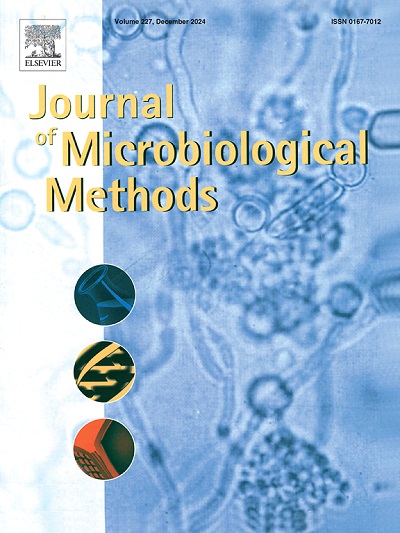Application of a rapid and sensitive RPA-CRISPR/Cas12a assay for BCSP31-based Brucella detection
IF 1.7
4区 生物学
Q4 BIOCHEMICAL RESEARCH METHODS
引用次数: 0
Abstract
Brucellosis, a zoonotic disease caused by Brucella species, poses significant health risks to humans and animals. Due to the limitations of current diagnostic methods, such as serological testing and PCR, in terms of sensitivity, specificity, and speed, this study explores the potential of integrating recombinase polymerase amplification (RPA) with the CRISPR-Cas12a system for Brucella detection. This combination leverages the strengths of both technologies for rapid, sensitive, and specific molecular diagnostics. RPA primers and CRISPR RNA (crRNA) targeting the Brucella-specific conserved sequence BCSP31 were designed, followed by optimization of the RPA-CRISPR/Cas12a system. Its performance was evaluated using genomic DNA from Brucella and non-Brucella species. The system's capabilities were assessed on clinical blood samples, demonstrating high sensitivity (detection limit of 10 copies per reaction and 16.6 attomoles for Brucella DNA) and excellent specificity. Testing on clinical samples showed strong agreement with qPCR results and an improvement over the RBT.
The RPA-CRISPR/Cas12a platform represents a rapid, ultra-sensitive, and accurate method for Brucella detection and holds promise as a valuable tool for brucellosis control.
快速、灵敏的RPA-CRISPR/Cas12a方法在基于bcsp31的布鲁氏菌检测中的应用
布鲁氏菌病是一种由布鲁氏菌引起的人畜共患疾病,对人类和动物构成重大健康风险。由于血清学检测和PCR等现有诊断方法在敏感性、特异性和速度方面存在局限性,本研究探索了将重组酶聚合酶扩增(RPA)与CRISPR-Cas12a系统整合用于布鲁氏菌检测的潜力。这种结合利用了两种技术的优势,可进行快速、敏感和特异性的分子诊断。设计了靶向布鲁氏菌特异性保守序列BCSP31的RPA引物和CRISPR RNA (crRNA),并对RPA-CRISPR/Cas12a系统进行了优化。利用布鲁氏菌和非布鲁氏菌的基因组DNA对其性能进行了评估。在临床血液样本中评估了该系统的能力,显示出高灵敏度(每次反应的检测限为10拷贝,布鲁氏菌DNA的检测限为16.6原子)和出色的特异性。对临床样本的测试显示与qPCR结果非常一致,并且比RBT有所改善。RPA-CRISPR/Cas12a平台代表了一种快速、超灵敏和准确的布鲁氏菌检测方法,有望成为布鲁氏菌病控制的宝贵工具。
本文章由计算机程序翻译,如有差异,请以英文原文为准。
求助全文
约1分钟内获得全文
求助全文
来源期刊

Journal of microbiological methods
生物-生化研究方法
CiteScore
4.30
自引率
4.50%
发文量
151
审稿时长
29 days
期刊介绍:
The Journal of Microbiological Methods publishes scholarly and original articles, notes and review articles. These articles must include novel and/or state-of-the-art methods, or significant improvements to existing methods. Novel and innovative applications of current methods that are validated and useful will also be published. JMM strives for scholarship, innovation and excellence. This demands scientific rigour, the best available methods and technologies, correctly replicated experiments/tests, the inclusion of proper controls, calibrations, and the correct statistical analysis. The presentation of the data must support the interpretation of the method/approach.
All aspects of microbiology are covered, except virology. These include agricultural microbiology, applied and environmental microbiology, bioassays, bioinformatics, biotechnology, biochemical microbiology, clinical microbiology, diagnostics, food monitoring and quality control microbiology, microbial genetics and genomics, geomicrobiology, microbiome methods regardless of habitat, high through-put sequencing methods and analysis, microbial pathogenesis and host responses, metabolomics, metagenomics, metaproteomics, microbial ecology and diversity, microbial physiology, microbial ultra-structure, microscopic and imaging methods, molecular microbiology, mycology, novel mathematical microbiology and modelling, parasitology, plant-microbe interactions, protein markers/profiles, proteomics, pyrosequencing, public health microbiology, radioisotopes applied to microbiology, robotics applied to microbiological methods,rumen microbiology, microbiological methods for space missions and extreme environments, sampling methods and samplers, soil and sediment microbiology, transcriptomics, veterinary microbiology, sero-diagnostics and typing/identification.
 求助内容:
求助内容: 应助结果提醒方式:
应助结果提醒方式:


